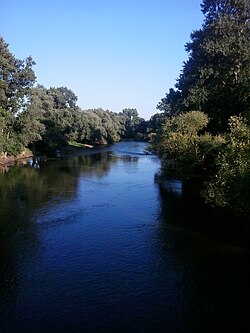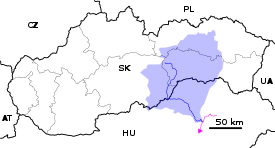Sajó
This article needs additional citations for verification. (February 2018) |
| Sajó Slaná | |
|---|---|
 The river between Sajóvámos and Szirmabesenyő | |
  Current and watershed of the Sajó River in Slovakia and Hungary | |
| Location | |
| Countries | Slovakia and Hungary |
| Physical characteristics | |
| Source | |
| • location | Stolica Mountains |
| Mouth | |
• location | Tisza |
• coordinates | 47°56′37″N 21°06′51″E / 47.9437°N 21.1142°ECoordinates: 47°56′37″N 21°06′51″E / 47.9437°N 21.1142°E |
| Length | 229 km (142 mi) |
| Basin size | 12,708 km2 (4,907 sq mi) |
| Discharge | |
| • average | 70 m3/s (2,500 cu ft/s) |
| Basin features | |
| Progression | Tisza→ Danube→ Black Sea |
| Tributaries | |
| • left | Hornád, Bodva |
| • right | Rimava |
The Sajó (Hungarian) or Slaná (Slovak) is a river in Slovakia and Hungary.
Its length is 229 km, of which 110 km is in Slovakia. Its source is in the Stolica Mountains range of the Slovak Ore Mountains. It flows through the Slovak town Rožňava and the Hungarian city Miskolc. In Hungary it flows through the county of Borsod-Abaúj-Zemplén. It flows into the River Tisza near Tiszaújváros. Its main tributaries are the Bodva and the Hornád.
Also known for Battle of the Sajó River from 11 April 1241 between the Mongol Empire and the Kingdom of Hungary.
Etymology[]
The origin of the name is the subject of scholar discussions. Hungarian linguists and historians suggested the derivation from the Hungarian sojó, só folyó (salt water, river) already in the 19th century.[1] Newer theories associate the name with sió referring to fast streams. According to Slovak linguists the name is pre-Hungarian (Slaná: salt river) and most likely not associated with the salinity but with the salt road existing already in times of Great Moravia. The supporters argue by numerous Slavic toponyms in the river basin and by local names related to soľ (salt) and Moravia like Moravce, Soľár, Solišče, Soľka, Soľník, Morava (according to this interpretation the Hungarian name is a later translation).[2]
References[]
- ^ Krško, Jaromír (2013). "Rudolf Odraz multietnicity karpatského regiónu v slovenskej hydronymii". In Žeňuch, Peter; Uzeňova, Elena; Žeňuchová, Katarína (eds.). Jazyk a kultúra na Slovensku v slovanských a neslovanských súvislostiach (in Slovak). Bratislava: Slavistický ústav J. Stanislava SAV, Slovenský komitét slavistov a Zemplínske múzeum v Michalovciach. p. 71. ISBN 978-80-89489-11-4.
- ^ Krško, Jaromír (2009). "Rudolf Krajčovič: Živé kroniky slovenských dejín skryté v názvoch obcí a miest - recenzia". Acta Onomastica (in Slovak). Praha: Ústav pro jazyk český AV ČR (L): 204–209. ISSN 1211-4413.
| Wikimedia Commons has media related to Sajó. |
- Sajó basin
- Rivers of Hungary
- Rivers of Slovakia
- International rivers of Europe
- Europe river stubs
- Hungary geography stubs
- Borsod-Abaúj-Zemplén geography stubs
- Slovakia geography stubs

